From the January/February 2015 issue of Sporting Classics.
Before I became a fisheries biologist, I was a fisherman. I grew up within arm’s reach of a fishing rod and caught bluegills in local ponds at age 4. Before I earned a driver’s license, I fly fished for brook trout in the high country of New Mexico. During graduate school, I entered the field of fisheries biology, and my love of fishing gave way to the cold, quantitative realm of research. At first, I could not reconcile the conflicting views. Fisheries biologists study fish, and fishermen catch them. It was that simple.
As time passed, however, this perceived conflict began to fade. I never forgot the thrill of that niggling pressure on the line, the anticipation of setting the hook, and the rush of adrenaline when the line screams from the reel.
So I picked up a rod again and began fishing alongside the captains and crews of our research vessels. We fellowshipped over fresh fish for lunch and stocked our freezers for the winter. I attended data workshops alongside experienced charter boat captains and seasoned biologists, as the scientists confirmed their findings with the captains’ innate sixth sense of the fishes’ movements and behaviors.
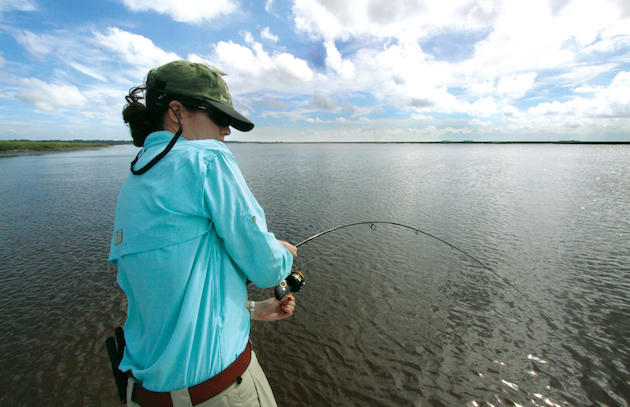
For years I waffled between these two identities but united them shortly after I accepted an invitation to visit Cabin Bluff, a world-renowned hunting and fishing retreat along the coast of southeastern Georgia. The lodge is framed by an expansive network of tidal marshes on the mainland and sits across the Cumberland River from Cumberland Island National Seashore.
Andy Ippensen, Cabin Bluff’s director of marketing, invited me to experience the resort’s superb fishing for its two signature species, spotted seatrout and redfish. I had monitored these species while conducting research for the South Carolina Department of Natural Resources. But this time I would be the fisherman instead of the biologist.
Spotted seatrout are a prime game species along the southeastern coast. While not related to freshwater trout, they reach about the same size, with distinctly silver scales dappled in dark spots.
Then there are the redfish, the premiere saltwater sportfish of the South. Reds possess astounding beauty, from the rose-gilded bulls in the open ocean to the coppery juveniles in the estuaries. Their scales are the colors of the sun: orange-red blending to bright white, with dramatic black spots on their tails.
Redfish go by several monikers, but fisheries biologists refer to them as red drum—and for good reason. During graduate school, I volunteered at the South Carolina Aquarium, diving and giving presentations in the Great Ocean Tank, which included several five-foot bull reds. On one particular dive, I felt the sound more than I heard it. A rhythmic series of booming pulses resonated in the water and thumped in my chest like a second heartbeat, pumping the audible vibration through my limbs. I traced the sound back to the bull reds, which were pounding their abdominal muscles against their swim bladders as a spawning signal. To this day, I still use the terms redfish and red drum interchangeably.
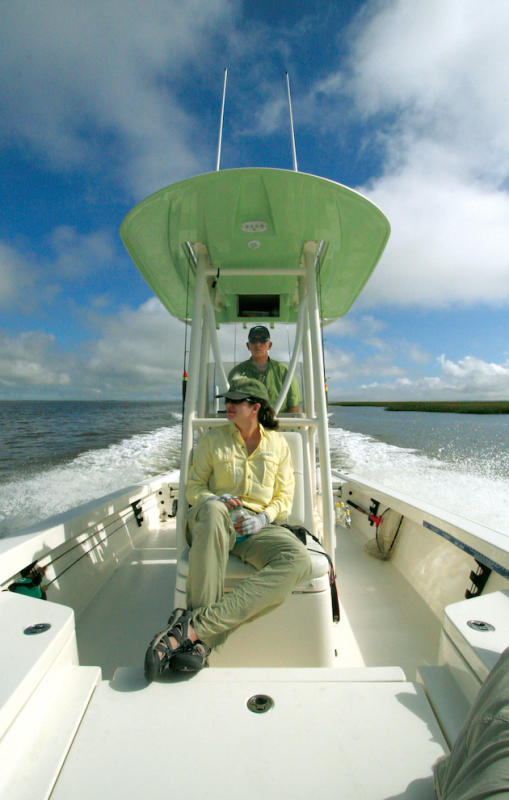
In early October I arrived at Cabin Bluff late on a pleasant and warm Wednesday afternoon and was immediately struck by the retreat’s inherent character and charm. Miles of pristine quail habitat, carefully managed by prescribed burns, stretched past the front gate and to the horizon. Beyond the main office, stately pines draped with Spanish moss shaded the sprawling complex of individual lodges that overlooked the expansive dock and endless marsh grasses. Strategically placed hammocks and porch swings offered picturesque views of the water while taking advantage of the shade and soothing offshore breezes. Woodstorks, snowy egrets, songbirds of nearly every variety, and alligators brought the trees, marshes, and water to life.
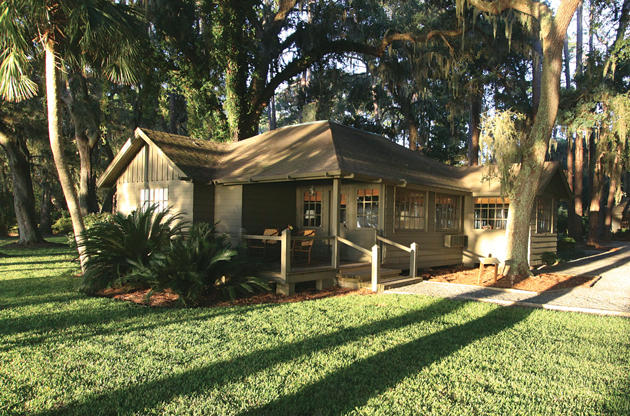 Cabin Bluff offers excellent accommodations and lodging.
Cabin Bluff offers excellent accommodations and lodging.
The lodge I occupied could have easily doubled as a family home. Three suites radiated from the central living space, books telling the history of Georgia lined the fireplace mantle, and vintage black-and-white framed photographs honored the decades of fellow hunters and fishermen who had communed beneath this same roof.
As if the grounds and lodges weren’t lavish enough, Cabin Bluff took Southern hospitality to the next level with its five-star dining. Executive Chef Rob Podrasky and Chef Departie Craig Lloyd dazzled their guests every evening with fresh local fare that fused high-class flavors and Southern charm, from pan-seared grouper and beef tenderloin to gourmet shrimp and grits.
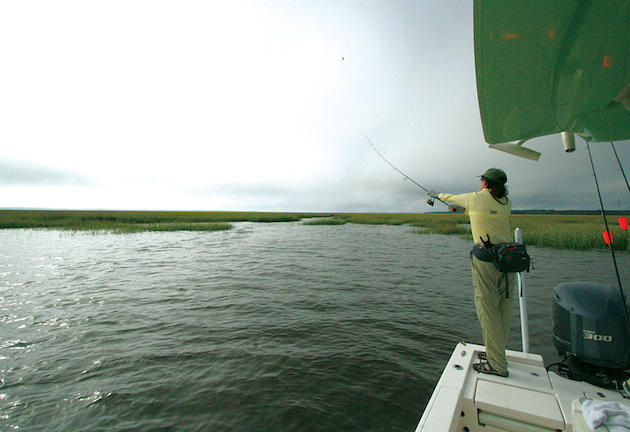
I spent a relaxing evening casting along the dock and acquainting myself with the hammocks and then began fishing in earnest on Thursday with Capt. Sean McCarthy, whose specialty is poling the flats for big redfish. We stowed our gear and cameras and set a course for the far side of the channel while discussing the finer things in life, such as science and music and, of course, fishing.
I had spent the past few months far inland, so I greedily inhaled that first breath of salty ocean breeze and exhaled a sigh of complete and utter relief. Sunshine streamed through puffy white clouds, and a gentle, early-autumn breeze kept the insects at bay. We headed south, with Cumberland Island off to port. Along the way, we saw snowy egrets, roseate spoonbills, and small herds of wild horses with gangly foals in tow along the beach while Sean shared some of the rich history of Cumberland Island, including its past inhabitants and native wildlife.
As the afternoon progressed I learned that fishing from a flats boat is an aquatic version of hunting. I had brought my 8-foot Abu Garcia rod with a Penn 712 Z reel that was almost as old as I was. I had used that rod since I was five years old, for everything from croakers off the piers at the Outer Banks in North Carolina to striped bass in Tennessee and was determined now to add to its extensive history by catching a redfish.
Unfortunately, history did not happen at our first location beside an old pier. Sean found the fish in abundance, evidenced by the puffs of mud that appeared when the reds moved, but they weren’t biting. I tried dry flies and artificial baits, but living next to the man-made structure had made the fish too wily to fall for such pale imitations of their usual prey.
We then headed north to a cluster of oyster reefs tucked against the thick marsh grasses and immediately saw signs of redfish. Finger mullet jumped in desperate acts of self-preservation, and we spotted the telltale mud puffs and triangular wakes created from the reds’ broad heads plowing through the water. I took the stage at the boat’s broad, sturdy bow while Sean cut the engine and assumed his vantage point on the poling platform, constantly adjusting our position with surgical precision.
“Forty feet – ten-o’clock . . . okay, he’s turning around and coming back toward you. Now cast at twelve o’clock as far as you can.” I pointed my rod tip in the direction indicated. “Left . . . left . . . a little more . . . there!”
The line flew from the reel, propelled by the weight of the grub. “Good cast . . . let it sit . . . okay, give it a twitch. Wait . . . twitch it again. Oh, he’s right there.”
An unmistakable, insistent pressure suddenly jolted the rod tip, and the water erupted. I set the hook and dimly heard Sean’s voice in the background. “Great job! Now enjoy the fight.”
Playing a fish can be like dancing. In this particular dance, the redfish was the leader, and I was the follower. I felt his movements through the line while the old spinning rod bowed reverently toward the water. I continually adjusted the angle of my body and the rod to match his pace. The line zipped from the spool, and I let him take it. Then as he slowed, I raised the rod tip and cranked the reel. We danced from the bow to the stern and back again until his coppery scales broke the water and I could glimpse his silhouette. When I was finally able to steer him into Sean’s broad net, I regarded my noble, scaled partner with a mix of awe and respect.
He was magnificent, more than 30 inches of pure muscle and spirit. Scales the color of burnished copper with rosy orange undertones shaded to a white belly, and a single large black spot stood out in stark contrast at the base of his tail. Deep orange eyes and dark pupils accented a broad, golden head where the outline of the scales faded, as though sculpted from a vein of solid metal.
Despite the thrill of the primal dance between human and fish, my favorite part was the release. It was a quiet, intimate, almost spiritual experience as I worked him back and forth in the water, saw his gills begin to move, and felt the subtle twitch of muscle and scale as he regained his strength.
I watched him vanish and had barely gotten the adrenaline out of my system when my reel sang again with another powerful redfish, just as fierce a fighter and every bit the jewel as the one before. She took a little longer to revive, and I worked with her for several wordless minutes until she gave two strong kicks and slipped from my hands.
By this time, we had worn out our welcome with the school, and the changing tides forced us back to the dock. I thanked Sean profusely for a most excellent day at Cabin Bluff and wondered how it could get any better.
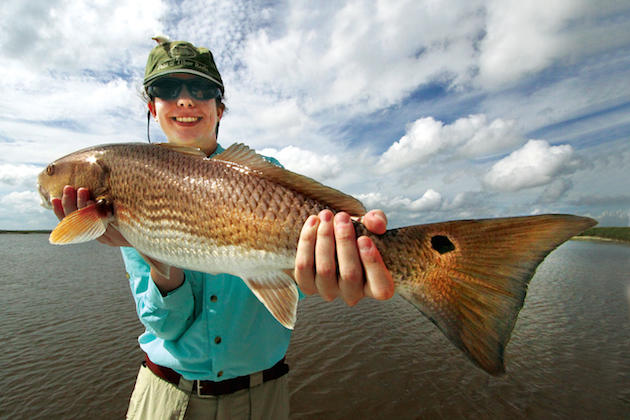
A thick fog lay over the water Friday morning but was quickly burned away by the rising sun, and I planned to fish with Capt. Toby Mohrman, one of Cabin Bluff’s most seasoned guides. He has a great sense of humor that can turn positively wicked, and we clicked from the first handshake.
“Here’s why I like being a fishing guide,” he told me as we pulled away from the dock. “One, I like talking to myself. Two, I like telling people what they’re doing wrong and getting paid for it!”
Toby specializes in light spinning tackle with popping corks and live shrimp, and we fished in small feeder creeks and shallow oyster reefs for seatrout and redfish. The morning started out promising with plenty of hits, and we had two sizeable seatrout in the cooler by lunchtime.
We picked up the pace in the afternoon, never staying in one spot for long. We would try a site, decide we could do better, and set off again, fishing tidal creeks and oyster beds of all sizes. Toby kept the day exciting, and the shadow of Cumberland Island provided an idyllic backdrop.
By the end of the day we had three dinner-worthy seatrout in the cooler, including an unusual specimen nearly devoid of spots. I also caught and released a smaller 14-inch redfish with rich copper scales, brilliant red fins, and three black spots near the tail. I counted the day a success, but Toby was determined to do better.
The good captain definitely came through on Saturday, and around mid-morning the water suddenly erupted with a marauding school of something that was definitely not redfish or seatrout.
“Toby, what’s moving over there?” I pointed to the boiling water.
“Jacks crevalle! Hang on to your hat!”
Toby wheeled the boat around, and I sent the chartreuse jig into the midst of the pack. The water exploded with the raw savagery of a huge jack’s hit. He must have weighed 20 pounds and fought viciously, stripping line with such force that I simply held on for the ride. It was a textbook fight until he snapped the line across an oyster reef. But as much as I wanted to land that fish, the fight alone was reward enough.
We hit the honey spot right before lunch at an oyster bed that slowly emerged from the water on the outgoing tide. I caught and released over a dozen redfish in the span of an hour, and at times I couldn’t make more than one or two casts between hits.
“Hey Cap’n, am I wearing you out with the net?”
“Are you kidding? I could do this all day!”
Something substantive changed in me during this time of communion. As a fisheries biologist, I had carefully masked my emotional attachment to the fish I studied, and with good reason. People trust scientists because we view the natural world objectively without any sort of emotional bias. But now, as a fisherman, the emotions—the light-hearted giddiness of the strike, the thrill and suspense of the fight and the genuine love for the fish—returned with staggering force. I connected with each fish through the fight, looked into their souls through their eyes, and marveled at their beauty as I released them.
After lunch, I hooked five more big redfish. Each was beautiful, some with multiple spots, others with a striking cobalt blue tint to the end of their tails, and with colors ranging from copper to amber to orange and every hue in between.
I could not have scripted this trip any better if I had tried, and I felt a pang of emotion as I said goodbye to my new friends at Cabin Bluff when I pulled out of the gate on Sunday morning.
Cabin Bluff offered me the opportunity to bridge the gap between fisherman and fisheries biologist, who both do what they do for the love of the fish.
And now I have the united perspective of both. +++
The writer thanks the following for helping make her trip a success: Cablz Eyewear Retention, fishing gloves from Glacier Gloves, shirts from Hook & Tackle, backpack from Umpqua Feather Merchants, Wiley X sunglasses, and line from Vicious Fishing. She welcomes your thoughts and feedback at Carly@TheNaturalistsQuill.com.
Be sure to sign up for our daily newsletter to get the latest from Sporting Classics straight to your inbox.

